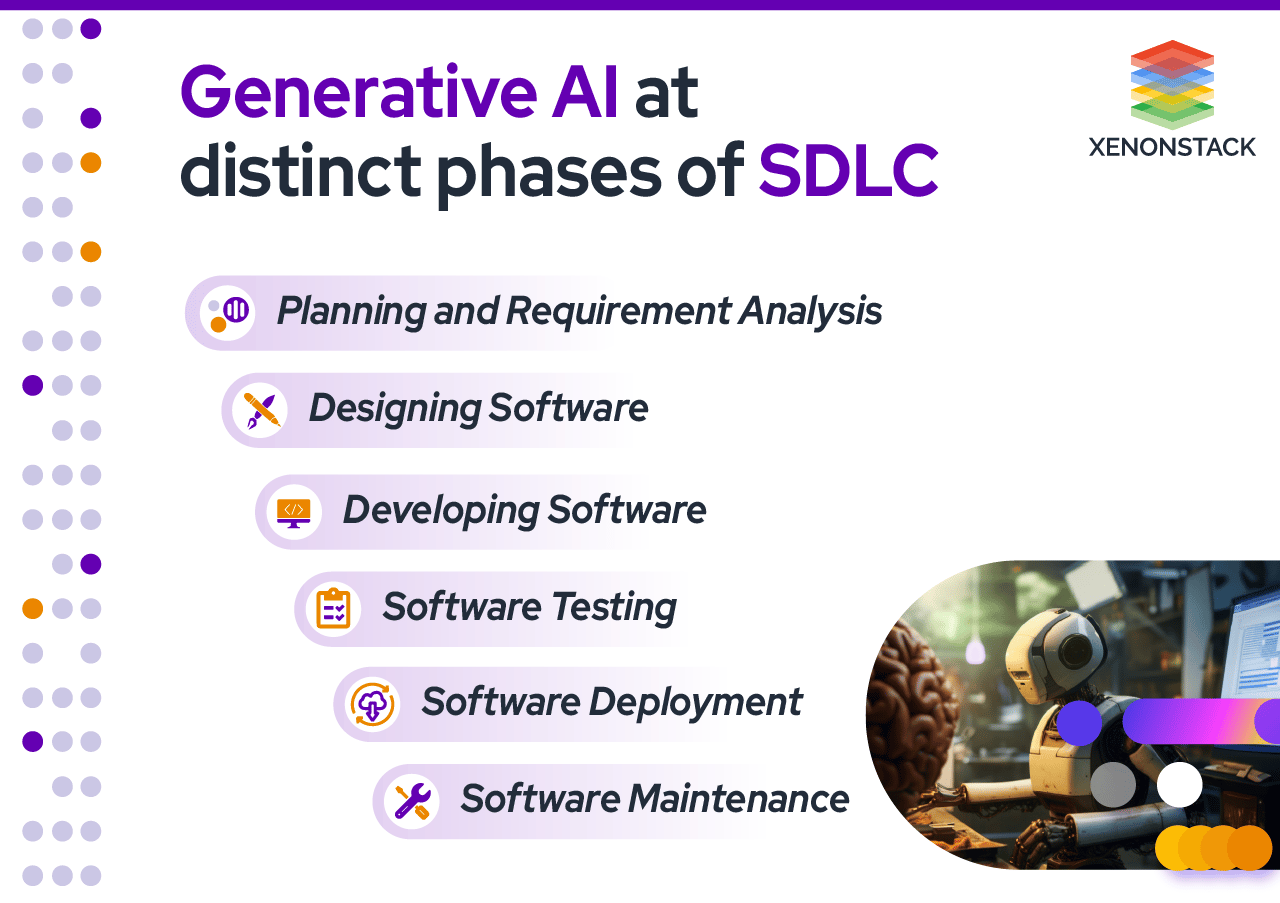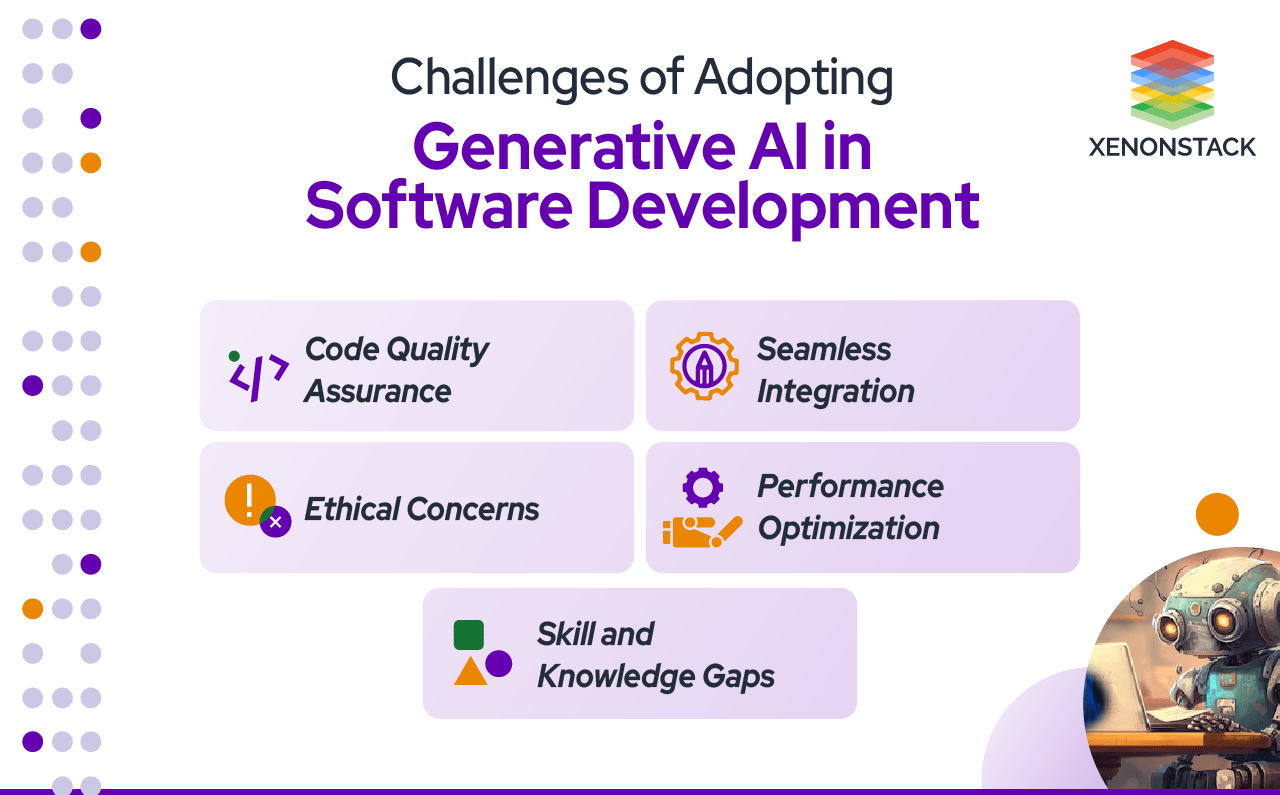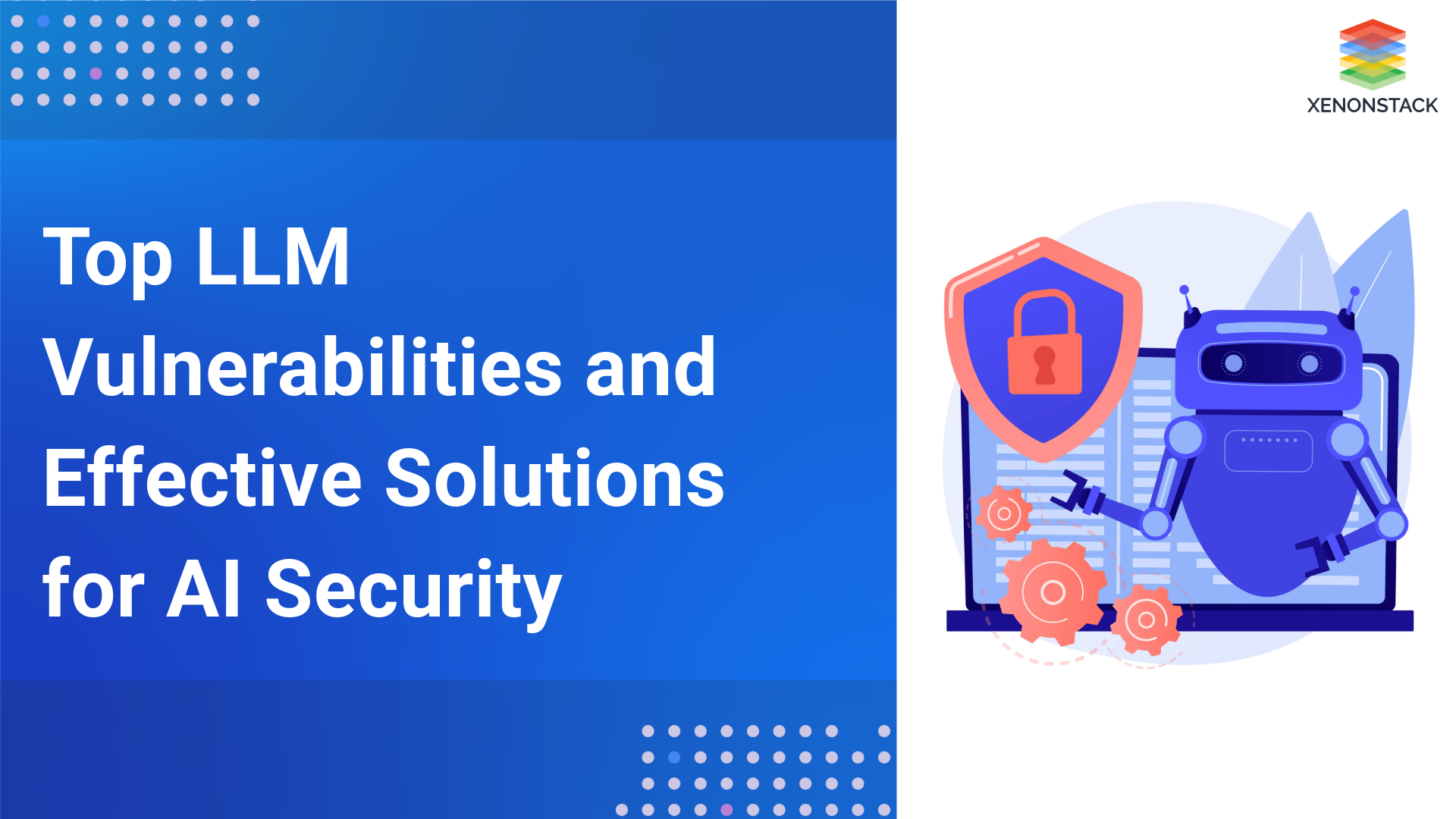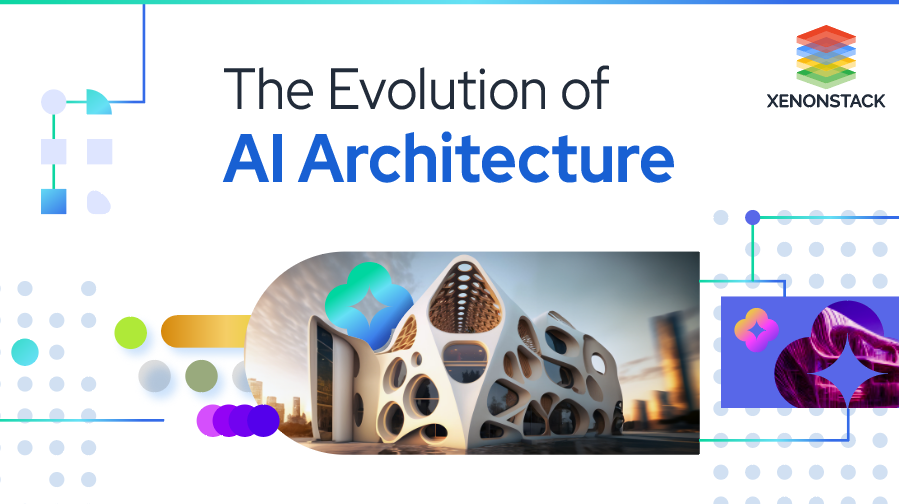
Revolutionizing Software Development with Generative AI
Generative AI is transforming the software development landscape, increasing time efficiency, heightened productivity, and enhanced software quality. Automating routine tasks like UI creation, testing, and documentation enables developers to concentrate on more intricate aspects of their work. Generative AI holds the potential to significantly reduce the development time for intricate codebases, resulting in quicker time-to-market for products. Moreover, it can elevate software development quality by reducing errors and enhancing user satisfaction and user enhancement with software applications.
Application of Generative AI at distinct phases of SDLC (Software Development Lifecycle)
Generative AI enhances software development by automating diverse tasks across the software development life cycle (SDLC). For example, it can help with requirements analysis, design, implementation, testing, deployment, and maintenance.
1. Planning and Requirement Analysis
The Requirement and Planning analysis phase is pivotal in delineating the project's scope, objectives, and feasibility within the software development life cycle.
Issue/Opportunity
Traditional planning and requirement analysis can be problematic due to their linear and sequential processes, leading to misunderstandings and scope changes. To address this, one can embrace an agile or iterative approach, ensuring continuous feedback, testing, and adaptation of requirements throughout the entire project lifecycle.
How can Gen AI help?
-
Generating, Validating, and Optimizing Requirements: Gen AI can generate, validate, and optimize requirements based on natural language inputs.
-
Identifying and Resolving Inconsistencies, Ambiguities, and Gaps: Gen AI can identify and resolve inconsistencies, ambiguities, and gaps in the requirements, contributing to the overall clarity and coherence of the project.
-
Providing Feedback, Suggestions, and Best Practices: Gen AI offers feedback, suggestions, and best practices to enhance the quality and clarity of the requirements and align them with industry standards.
-
Facilitating Collaboration and Communication: AI enhances collaboration and communication within stakeholder and developer networks, promoting a more efficient and streamlined development process.
2. Designing Software
Software development involves using engineering principles, techniques, and resources to produce products that meet users' and stakeholders' requirements.
Issue/Opportunity
Traditional software design can be inflexible and slow to adapt, but it offers clear documentation and a well-defined scope. The waterfall model's approach can lead to delayed feedback and difficulty accommodating changes.
How can Gen AI help?
-
Generating Code using Sketches or Natural Language Specifications: The platform automates the code generation process and utilizes natural language specifications or sketches to enhance the efficiency of the design process.
-
Recommending Best Practices and Design Patterns: Gen AI provides recommendations for best practices and design patterns, assisting developers in creating more robust and maintainable software.
-
Automation of testing and debugging of code: The main task in this step is to ensure that the generated code adheres to specified requirements and remains error-free.
-
Optimizing Code for Performance and Security: Gen AI optimizes the generated code for both performance and security, contributing to the overall quality and efficiency of the software.
3. Developing Software
Software development starts with implementation and then moves to testing and maintaining computer software that can help solve problems or perform specialized tasks.
Issue/Opportunity
Balancing planning and agility in software development can be challenging. The rigid waterfall and agile models introduce risks, especially for large-scale projects.
How can Gen AI help?
-
A Platform based on AI-Powered Applications: Gen AI enables software developers to effortlessly and swiftly create and deploy AI-powered applications.
-
Comprehensive Tools and Services: Gen AI provides various tools and services, including data ingestion, labelling, model training, model deployment, model monitoring, and model optimization, suggesting a comprehensive approach to the AI development lifecycle.
-
Leveraging Cloud Computing, Distributed Systems, and Machine Learning: The platform leverages the capabilities of cloud computing, distributed systems, and machine learning to deliver scalable, reliable, and efficient solutions across different domains and use cases.
-
Collaborative Environment: Gen AI provides a collaborative space where developers can share projects, insights, and feedback, cultivating knowledge exchange and community engagement.
-
Democratizing AI: Gen AI seeks to democratize AI by providing accessibility to developers, ensuring that AI technology is available to a wider community beyond specialized experts.
4. Testing
Software testing validates that a software product meets user and stakeholder requirements at distinct stages of development.
Issue/Opportunity
Traditional software testing, with its manual processes, tends to be time-consuming, error-prone, and costly. Integrating automated testing tools enhances efficiency, accuracy, and the overall scope of testing, thereby facilitating continuous integration and delivery practices.
How can Gen AI help?
-
Generating Test Cases Based on Natural Language Specifications: The system can interpret and derive test cases directly from natural language specifications, streamlining the testing process by automating the creation of test scenarios.
-
Automation of Execution and Validation of Test Cases: The system automates the execution and validation of test cases, ensuring that the software under test is exercised according to specified scenarios.
-
Providing Feedback and Insights on Testing Quality and Coverage: The system offers feedback and insights on the quality of the testing process, including information on the effectiveness of test cases and coverage metrics.
-
Learning from Previous Test Results and Improving Over Time: The system can learn from previous test results, adapting and improving its testing approach by analysing historical data to identify patterns, trends, and areas for enhancement.
5. Deployment
Software deployment makes a software system or update available for use by intended users.
Issue/Opportunity
Traditional deployment methods involve manual coordination between developers and operators, resulting in errors, delays, and inefficiencies.
How can Gen AI help?
-
Automating the deployment processes of AI Models: Gen AI functions as a dedicated platform that aims to streamline and simplify the implementation of AI models, utilizing automation to improve the overall deployment procedure.
-
Simplifying the Deployment Process: Gen AI aims to simplify the deployment process, reduce its complexities, and contribute to its efficiency and ease of use.
-
How to Reduce Errors: By automating the deployment process, Gen AI minimizes the risk of human errors, promoting consistency and accuracy in the overall workflow.
-
Saving Time and Resources: The platform saves time and resources by automating deployment tasks aligning with AI and technology trends to optimize workflows and increase efficiency.
-
Scalable Infrastructure: The platform offers a scalable infrastructure that adapts to varying workloads and accommodates the deployment needs of different AI models.
-
Secure and Reliable Service: Gen AI focuses on providing a secure and reliable service, which is crucial for dealing with AI models in deployment scenarios.
6. Maintenance
Software maintenance involves modifying, updating, and fixing software after deployment. Manual maintenance processes are prone to errors and inconsistencies, leading to inadequate quality and increased costs.
Issue/Opportunity
Manual maintenance processes and documentation are prone to errors and inconsistencies, resulting in inadequate quality, increased costs, and reduced customer satisfaction. Automated tools and techniques can streamline maintenance, ensure compliance with standards and best practices, and enhance software performance and reliability.
How can Gen AI help?
-
Analysing Data for Risk Identification: The platform analyses data from sensors, logs, and reports to identify potential failures and risks, enabling proactive maintenance.
-
Recommendations for Preventive Actions and Optimal Schedules: Gen AI provides recommendations for preventive actions and optimal schedules for maintenance tasks, contributing to reducing downtime and extending equipment lifespan.
-
Automation of Routine and Repetitive Tasks: Gen AI automates routine and repetitive tasks using robotics and digital assistants, speeding up processes and freeing human resources for more complex tasks.
-
Real-time Feedback and Guidance: Offering real-time guidance and feedback to managers, the platform ensures that stakeholders are well-informed about maintenance tasks, facilitating more informed decision-making
How GenAI is changing the SDLC
At Xenonstack, our organization-wide deployment of Generative AI has significantly enhanced software development, delivering remarkable outcomes across ten key areas. If you're developing software in-house, these use cases are worth exploring. Alternatively, if you're sourcing software, seek providers capable of delivering similar value to benefit your business.
-
Automated Product Feature Generation: With the right inputs, Generative AI can produce detailed, relevant features in standardized, user-friendly templates.
-
Efficient Solution Design: GenAI standardizes and automates solution architecture and systems design, saving time and costs while enabling teams to reuse components for further efficiency.
-
Streamlined User Stories: GenAI simplifies complex requirements into user stories and generates acceptance criteria, helping teams save valuable time.
-
Automated Wireframe Creation: GenAI generates wireframes to accelerate development timelines by analysing desired features and context.
-
Accelerated Test Case Generation: GenAI analyzes acceptance criteria to create test cases covering a broader range of scenarios than manual efforts, reducing time and minimizing costly fixes.
-
Data Synthesis for Testing: GenAI synthesizes domain-specific data for regression testing, prototyping, and more, enhancing quality while reducing reliance on sensitive real data.
-
Automated Test Script Creation: GenAI generates user acceptance testing (UAT) scripts based on acceptance criteria and uncertainties, boosting the speed and efficiency of quality assurance.
-
Rapid Troubleshooting: GenAI compares intended and actual outputs for root cause analysis and automates tasks like upgrading software libraries and re-platforming.
-
Code Completion and Review: While not fully capable of generating complex code independently, GenAI enhances productivity by offering intelligent code completion, refactoring suggestions, and automated code reviews.
-
Seamless Documentation: GenAI automates software documentation, making troubleshooting easier and facilitating smoother handoffs between teams. It also effortlessly generates release notes and user guides.
Challenges in Adopting Generative AI in Software Development
-
Ensuring the Quality of Code: Addressing the critical challenge of maintaining the quality, reliability, and security of AI-generated code involves identifying and resolving issues such as bugs, vulnerabilities, and unintended behaviours.
-
Seamless Integration: Integrating the generated code seamlessly with existing codebases and frameworks can be challenging due to differences in coding styles, architectures, and dependencies.
-
Addressing the ethical Concerns: Addressing ethical considerations in Generative AI involves managing issues like biases in code generation, unintended propagation of stereotypes, and preventing potential misuse.
-
Performance Optimization: Evaluating and optimizing the performance, scalability, and efficiency of Generative AI systems to meet the demands of real-world software development projects.
-
Skill and Knowledge Gaps: Bridging the gap in skills and knowledge among software developers and end-users regarding the use and interaction with Generative AI software.

Learn about the Role of Generative AI in Generate Synthetic Data
Click to explore Log Analytics with Generative AI
Explore how enterprises are empowering Applications with Large-Scale Generative AI Models at xenonstack.ai.




